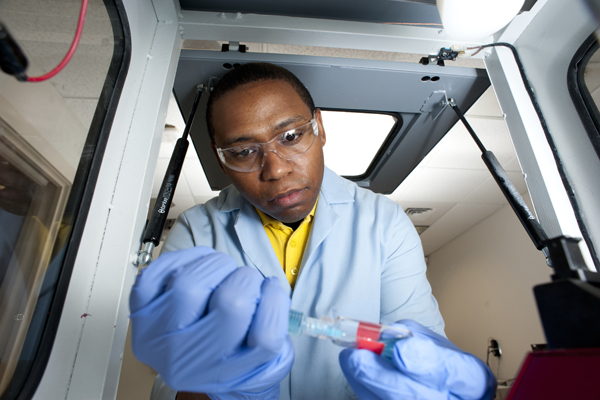The secret life of serotonin

As a graduate student, Chris Skipwith studied cardiovascular disease and was particularly interested in the biophysics of the proteins involved in blood clotting. “We were very interested in how clotting is related to the development of cardiovascular disease,” Skipwith said, “but we didn’t have many tools to be able to do in vivo studies.”
So after earning his degree from the University of Pennsylvania, he decided to invent some new ones. To do so, he signed on as a post-doctoral researcher at Northeastern in associate professor of pharmaceutical sciences Heather Clark’s lab.
Clark’s lab in the Bouvé College of Health Sciences develops nanosensors for monitoring a wide range of biological parameters. For example, they’ve created tools that allow diabetic patients to measure blood glucose levels noninvasively. More recently, they’ve been developing sensors that allow them to take a closer look at the brain by examining neurotransmitters as they’re secreted from individual neurons.
This turned out to be a perfect angle for Skipwith, whose interest in cardiovascular disease is directly related to the neurotransmitter called serotonin, which is typically associated with mood. This small molecule is secreted throughout the body—not just in the brain—including by the platelets that congregate around a site of blood vessel injury.
Many biological clues suggest that serotonin, as well as other small molecules released from platelets when they are activated during clotting, play an integral role in cardiovascular disease. In addition, Skipwith noted that “studies have shown that people who have suffered through major depression are more than four times more likely to have a heart attack.” But to date, researchers have not been able to study those interesting results in more detail because they’ve lacked the ability to observe the molecules in real time and at the exact location of a blood clot.
“They are metabolized so quickly that you can’t actually look at the small molecules themselves—you have to look at metabolites of them,” Skipwith said. This is fraught with problems, he explained, because multiple processes in the body could generate the same metabolites and they, too, are short lived.
To overcome this challenge, Skipwith will be developing a new set of nanosensors specifically designed to look at small molecules at the site of a blood clot. This work is supported by two recently awarded fellowships—one from the Ford Foundation, and the other from the United Negro College Fund and Merck Pharmaceuticals.
The question he hopes to answer is whether individuals predisposed to cardiovascular disease have higher serotonin levels than everyone else. The fellowships will provide the resources to make the nanosensors behave just like platelets. The only difference is that once they get there, the platelet’s job is to stop the bleeding, whereas Skipwith’s nanosensors aim to detect serotonin levels being secreted by the platelets themselves. The nanosensors will have the same shape, flexibility, and surface chemistry as the platelets and will thus be able to incorporate into clots. This will put the nanosensors in a prime location for detecting the amount of serotonin being secreted by their neighbors.
Initially, Skipwith will develop the system to work with cells grown outside of the body. After that he hopes to optimize the system to be used inside live animal models—and eventually humans.
“It may be that patients who are prone to cardiovascular disease need some type of serotonin therapy,” Skipwith said, citing selective serotonin reuptake inhibitors typically used as antidepressant drugs as an option currently being discussed among health professionals. “Just having that type of knowledge could inform treatment for cardiovascular disease.”
After he completes his fellowships, Skipwith hopes to start his own research program, using the tools he develops in Clark’s lab to ask those needling questions he was never able to answer before.





